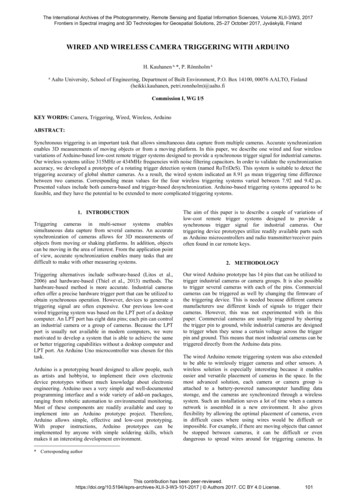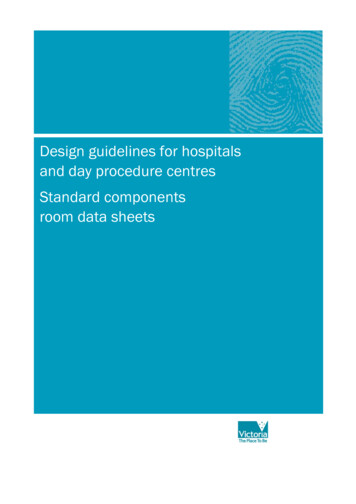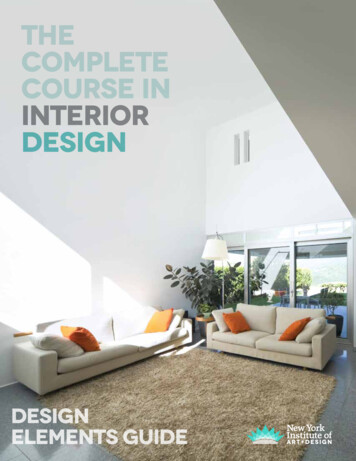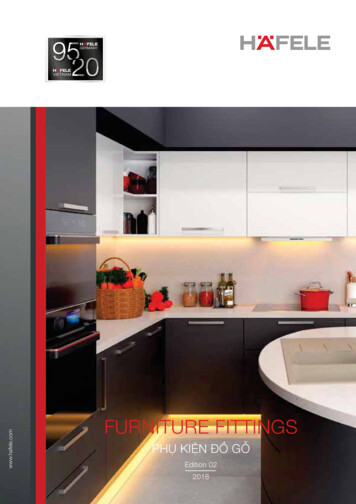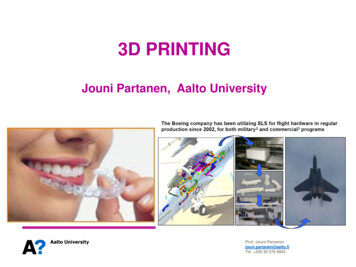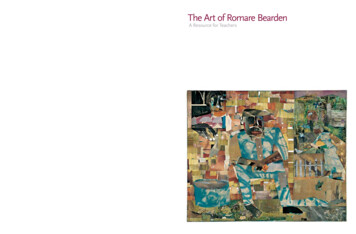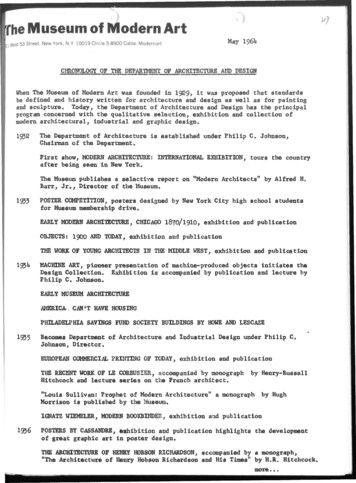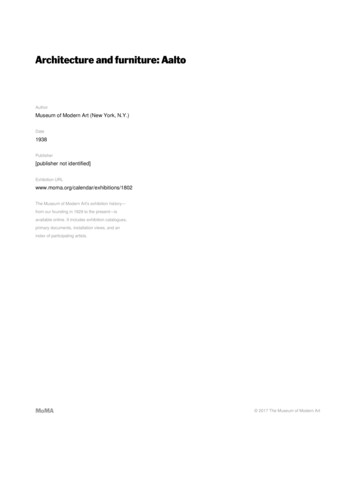
Transcription
Architecture and furniture: AaltoAuthorMuseum of Modern Art (New York, N.Y.)Date1938Publisher[publisher not identified]Exhibition URLwww.moma.org/calendar/exhibitions/1802The Museum of Modern Art's exhibition history—from our founding in 1929 to the present—isavailable online. It includes exhibition catalogues,primary documents, installation views, and anindex of participating artists.MoMA 2017 The Museum of Modern Art
LIBRARYTHEOF MOOtftNAFtl
mlmm-
ARCHITECTUREAXDFURNITUREA ALTOTHEMUSEUMOF MODERNARTNEWYORK
PvrcXx l T,NEWYORK
1FOREWORDSix years ago when the Museum of Modern Art opened the first exhibition of modern architecture in this country, attention was focused on thefundamental qualities of the new "InternationalStyle." The work ofGropius, Mies van der Rohe, Oud, Le Corbusier and others was shownto have been conceived with a basically functionalist approach, and tohave been carried out with a common set of esthetic principles.Since then, modern architecture has relinquished neither the functionalist approach nor the set of esthetic principles, but both have beenmodified, particularly by the younger men who have since joined theestablished leaders. Among these none is more important than Aalto.Like the designs of other men first active in the '30's, Aalto's work,without ceasing in any way to be modern, does not look like the modernwork of the '20's. The younger men employ new materials and newmethods of construction, of course, but these only partly explain thechange. The buildings of men working naturally in an already established style are less assertive of that style's tenets than those earlier andmore puristic buildings which were establishing the style with a necesarily stringent discipline. Certain materials and forms once renouncedbecause of their association with non-modern work are now used again,in new ways or even in the old ones. To the heritage of pure geometricshapes, the younger men have added free organic curves; to the stylisticanalogies with the painters, Mondrian and Leger, they have added Arp.Personal and national qualities are more apparent than a decade ago.Aalto's designs are the result of the complete reconciliation of a relentless functionalist's conscience with a fresh and personal sensibility.This reconciliation demands tact, imagination and a sure knowledge oftechnical means; careful study of Aalto's buildings show all three inabundance. The personal character is most obvious in the delightfulinventiveness of his forms and his handling of materials. The nationalcharacter, closely allied, can be seen in the general Scandinavian trimness, and above all in the use of wood, Finland's principal building material. Aalto's thorough knowledge of the various properties of woodguides his imagination in putting them to work architecturally, underthe direction of his unique esthetic sensibility.1Including the recent work of many of the older men, Le Corbusier, Gropius, Mendelsohn, etc.3
1In his furniture, the audacious manipulationof wood might be thoughtbravura were it not always justified by the physical propertiesof thematerial. As in his architecture,Aalto's designs are a result of the samecombinationof sound construction,suitability to use and sense of style.Any one of the chairs is the result not only of a painstaking study of posture, the properties of laminated wood and esthetic considerations,butalso of the study of efficient (and consequentlyeconomical) mechanicalmethods of mass-production.In fact, a major distinction of the furnitureis its cheapness. Low-cost housing of good modern design has been produced for the last fifteen years; now, probably for the first time, a wholeline of good modern furniture is approachingan inexpensive price level.On behalf of the President and Trustees the Curatorwishes to thank the following owners of Aalto furnitureosity in lending to the exhibition:Miss Marion Baconof Architecturefor their generMr. and Mrs. Russell LynesMr. Herbert MatterMr. Howard MyersMr. Geoffrey BakerMr. and Mrs. Carl F. BrauerMr. and Mrs. Alistair CookeMr. Harmon GoldstoneMiss Ruth GoodhueMr. and Mrs. George NelsonProf. Henry-Russell Hitchcock, Jr.Mr. and Mrs. A. Lawrence KocherMr. and Mrs. William LescazeMr. and Mrs. John LincolnMr. and Mrs. Beaumont NewhallProf, and Mrs. Quincy PorterMrs. William Turnbull, 2ndThe Finnish Travel and Information Bureau, New YorkThe KaufmannStore, PittsburghMr. and Mrs. Joseph H. LouchheimMrs. Mary Cooke of the Museum staff has been largely responsiblefor assembling and installing the exhibition.Mr. Harmon Goldstone,Mr. Simon Breines, Mr. A. Lawrence Kocher and Mr. Y. A. Paloheimohave given special assistance in the preparationof the exhibitionandthe catalog.JOHN McANDREWCurator of Architecture and Industrial Art1Additional information on Aalto furniture may be obtained from the Department4of Architecture.
ARCHITECTURE1,The modern movement in architecture since the War has producedonly a few figures of the stature of Alvar Aalto. Had his major designsbeen executed in the great countries of Europe, instead of in his nativeFinland, he would today be well-known throughout the world. As it is,the present exhibition of Aalto's work represents the formal introduction of this great architect to the American public.Alvar Aalto is today 40 years old; he was still a student when theWorld War ended. By that time Finnish architecture had already passedthrough a period of romantic nationalism which had begun in the late19th century. The leading figures in this self-consciously "native" movement were Gallen, Londgren and Eliel Saarinen, of whom Saarinen isbest known to America because of his widely popular and much imitateddesign for the Chicago Tribune Building (awarded second prize in theinternational competition of 1922), and his subsequent work at theCranbrook School in Michigan. But the movement from which Saarinen swork stems has long been spent. In Finland today a more rational although no less expressive architecture flourishes healthily.The great surge of building activity in Finland following the Warbrought with it new architectural ideas and forms from western Europe.These ideas, exemplified in the work of Gropius, Le Gorbusier and Oud,first took root, naturally enough, in Turku (Abb) Finland's Balticport. Here, a small group of young architects, stimulated by contact withthe Congres Internationaled'ArchitectureModerne (CIAM), beganthe struggle to introduce the new doctrines to Finland. In the forefrontwere Alvar Aalto, Erik Bryggman and others.Many obstacles beset the progress of the Turku group. They had toovercome the traditional prejudices not only of the public but also ofother architects, particularly those who served on competition juries.The romantic nationalism of the pre-war period was no longer a strongfactor in Finland's architectural development, but in the 1920's the newmovement was impeded — as, to some extent, it is even today — by theinfluence of the fashionable and chaste classicism of the Swedish andDanish pseudo-moderns.Place names are here given in Finnish. 1 he Swedish forms also in common use are given in parenthesis. But Helsingfors (Swedish) , well established in English, will he used instead of the FinnishHelsinki.5
Aalto's first great opportunity came in 1927 when he won the competition for the Viipuri (Viborg) Municipal Library with a straightforward modern design. The site was on the edge of a wooded parkneighboring a large pompous church in the neo-Hanseatic Gothic manner. The local clergy, and others, were alarmed at the threatened proximity of what they considered an architectural outrage and they set towork to prevent its realization so successfully that construction was putoff until 1934. Fortunately, however, this seven year delay was used byAalto to prepare an entirely different design, far more carefully studiedin detail. Aalto considers the Viipuri Library the first building he hashad time to finish properly.While the library project was being delayed by ecclesiastical opposition, Aalto continued to practise and to engage in several architecturalcompetitions. In 1928-1929, the newspaper offices and printing plant ofthe Turun-Sanomat in Turku were constructed from his designs. In thisreinforced concrete building, particularly in the great room housing theprinting presses (plate 1), Aalto demonstrated his growing sureness inthe functional approach and his vigourous imagination and tact in theuse of materials. The sturdy tapered piers and mushroom capitals are notonly the natural forms resulting from reinforced concrete construction,but are also vividly expressive of it.While the influence of the new architecture was spreading to thewhole of Finland, Aalto set up his office in Helsingfors. There he founddesigners of similar views, among them young Yrjo Lindegren who waslater to design the great Helsingfors Olympic Stadium now Hearing completion. As more and more competitions were won and more projectscompleted by the young architectural radicals, the public granted thema greater measure of confidence.sanatoriumat paimio(PEMAR) In 1932, work began on oneof Aalto's greatest buildings, the South-West Finland Tuberculosis Sanatorium outside the little town of Paimio just north of Turku. Two hundred and ninety patients and a staff of doctors, nurses and maintenanceemployees make up a completely self-contained community.From the pictures of the model and the isometric drawing (plates 5and 3) the Sanatorium is seen to be composed of a long main wing "A"housing the patients; a central block with stairs, elevators and othervertical services; a smaller wing B for the dining room, social rooms6
8and clinic; a "hotel section "C" for the hospital staff and generalkitchen; and the power house group "D". Set around the main structure are the doctors' homes "E", the employees' building "F" and thegarage "G".The disposition of these elements is the result of a carefully coordinated plan whereby the functions of each separate block are takeninto account and all are considered in relation to the natural characteristics of the site, the surrounding country and the all-important sunlight. For example, the main wing '"A" faces SSE in order that eachpatient may receive the full morning sun directly on his bed; the blockof open-air terraces at the end is bent slightly southward to enjoy themidday and afternoon light. The wing "B" containing the dining roomand social rooms is turned so that these spaces too may be flooded bythe direct rays of the sun. The other elements of the plan are phototropically oriented with similar care.The illustrations indicate the qualities of the Sanatorium buildings;these striking architectural effects are not achieved at the expense of theoccupants, nor, as so often happens, with inadequate regard for them.Aalto's architectural credo stresses the necessity of satisfying the requirements of the people for whom any structure is built. At Pairnio theordinary patient spends 60 percent of his time in bed, the severe case100 percent. With this in mind, Aalto designed as his basic unit a twobed room conceived in terms of the tubercular patient's physical needsand the psychological effect on him of his surroundings. To save theeyes of anyone lying 011his back from the reflected glare of shiny hospital-white, the walls are painted a soft indefinite tone and the ceiling ashade darker. Natural light pours through the window; artificial lightis placed above and behind the head of each bed so that the light sourceis never in the patient's line of vision. The usual hospital room is notonly visually harsh; it is also acoustically disturbing because of its hardslick surfaces. At Paimio three walls of each room are "hard" and oneis "soft." The "soft" wall is made of thick slabs of insulating board covered with a jointless cellular material about l/ inch thick. The usualhospital noises are conspicuously absent.In many details, particularly in those which relate most closely to theoccupants themselves, Aalto reasserts his ingenuity. The ordinary washbasin causes water to splash. As hand washing is necessarily frequent ina hospital, Aalto designed a special basin which receives the falling water7
4at an angle of 30 degrees without splashing. Continuing his analysis —and solution —of even the smallest problem relating to the patient, hedesigned a door knob which really fits the hand, has good leverage, protects the doot and does not catch clothing. His fool-proof swinging doorcloses itself easily by the automatic action of gravity. A low-temperatureheating panel forms a large part of the ceiling and in combination withthe ingenious, draftless window ventilation insures a constant temperature with a minimum of dust-laden air currents. The wardrobes aremade of light plywood hung from the wall, so that they do not interferewith easy cleaning of the room.The standard room units are piled six high like great building blocksto form the main wing of the Sanatorium. On its roof and at the easternend of each floor are open-air terraces where the occupants of the sepaiate units assemble during the sun-bath period, d he psychological1elation bettveen the individual and the group 111a tuberculosis sanatoi 111111is a veiy delicate one. Aalto s scheme, successful in practice, pro\ ides tv o kinds of terrace space —a large roof garden for new and lessinfectious cases, accommodating 120 patients in groups of 20, and smallsolai iums foi more serious cases with 24 couches in groups of four. Itwas Aalto s idea that, with a little care, the doctors could nurture thespecial character of each group, and by encouraging an easy transferfrom group to group make it possible for each individual to find themost congenial milieu.The construction throughout is reinforced concrete. Outside wallsconsist of 4 inches of concrete with a 4 inch facing of brick and a 11/inch interior facing of compressed cork. No formwork was used in pournig the conciete of these walls, for the brick and cork membranes wereset up first and the concrete was poured into the space between. Thebrick is surfaced with stucco and the cork with plaster.It is not possible to discuss all the detailed problems and their solutions here; the sum and synthesis of all these solutions produce thefinished structure. This is not to say that the form of the whole followsautomatically from the solution of the parts. Aalto is 110relentless theorybound functionalist; he feels that a completely rational architecturemust be esthetically expressive. His esthetic is not at variance with thedemands of function but is, rather, a living part of it.8
LIBRARY at viiplri(VIBORG) After a seven year delay, Aalto'srevised but not compromised design for the Viipuri Municipal Librarywas placed in construction in 1934. It was opened a year later, and inplanning and equipment remains one of the most efficient libraries inEurope. A visit to Viipuri reveals that the local clergy were wiser thanthey knew; not only the church but almost any other structure wouldhave suffered in juxtaposition to this novel and handsome building(plate 10).Here in one great design are found the discipline of a true functionalist, the imaginative expression of a vivid and original artist and theintegration of both qualities with contemporary industrialized building technique.It is characteristic of Aalto's buildings that they "read" clearly evento the layman. The Library is a highly complex design, but the elements are so well arranged that their relationship and purpose are madeapparent immediately.The Library has two functions; in addition to the normal libraryservices it provides a community auditorium, club rooms and buffetfacilities. The larger block houses the library proper, and the smallercontains a lecture room on the ground level and club rooms on the floorabove. The larger block consists of one great windowless room, illuminated through a series of circular light-wells in the roof. An upper levelof this room is used for the circulation desk and book shelves; a lowerlevel for reference and study. The children's reading room is on a stilllower level. I he library office is in the center and communicates directlywith the several librarians' desks and, by lower corridors, with everyother portion of the building. From the librarian's commanding centralposition, it is possible to observe and control all three sections of thelibrary.The most striking feature of the main reading room is the overheadindirect illumination. Although the 57 circular light-wells are 6 feet indiameter they are so designed that no direct sunlight can penetrate tothe room. As the maximum angle of insolation in Viipuri is 52 degrees,the sun is never high enough to send rays straight down through any oneof the deep wells. The rays pass first through a sheet of prismatic diffusing glass, strike the conical sides of the well and are then reflected downinto the room. Each circular opening sends down a larger circle of diffused light which is overlapped by neighboring circles of light, so that9
a reader's book is lit from many indirect sources at once and a whitepage cannot reflect light up into his eyes. The books on the shelves aresafe from the harmful effects of direct sunlight. The vast room is bathedin a soft shadowless light, ideal for reading, conducive to quiet. At nightthe artificial light is reflected from the high white walls above the bookcases, and is equally restful and diffused.The smaller building block shown in the air-photo (plate 10) contains an auditorium on the ground floor. Whereas the library rooms arewindowless in order to shut out those factors inimical to quiet and study,one whole side of the lecture room is clear glass opening out broadly tothe leafy park. This hall is used by the community for lectures, debatesand meetings. In keeping with the democratic traditions of the old city,the room was designed so that members of the audience rising to speakin any one part of the auditorium would have the acoustical advantagesusually reserved for the man on the platform. The wave-like contour ofthe sound-reflecting wood ceiling (plate 16) was the result of detailedstudy and experimentation:a tract of dead forest provided the 30,000knotless Karelian pine strips.Wherever wood is used, it is neither painted nor stained, but left todisplay the integral beauty of its color and grain, for esthetic as well aspractical reasons. Both the Sanatorium and the Library have furnitureof Aalto's design, and it, too, shows the natural beauty of the wood,varied by occasional painted surfaces. Seen always against the white ofthe walls, the woods take on a more positive color and ornamental pattern. The photograph of the main stairway (plate 12) shows anothercharacteristic simple and fresh device, the use of climbing plants as ageneric element of architectural design.Simple though it is, the building never seems dull nor severe, forevery glance discovers some handsome and practical innovation, like thereading room or lecture hall ceilings, or finds some pleasant new combination of plaster, wood, glass, multicolored books and green foliage.THEFINNISHPAVILIONAT THEPARISEXPOSITIONIt is agreat tribute to the system of open architectural competitions that,through this method of selecting a design, Alvar Aalto won the opportunity to produce several of his finest buildings. This fact should causeus in the United States to regret that the competition idea is so infrequently resorted to here. In 1936, Aalto won a competition for the design10
of the Finnish Pavilion at the 1937 Paris Exposition. Most critics areagreed that this Pavilion was one of the two or three most distinguishedin Paris and that it represented a vigorous expression of the work andculture of the Finnish people, as well as a personal triumph for Aalto.The Finnish Pavilion stood on a very prominent site to the right ofthe Trocadero Gate. In character with his own modesty and that of hiscountry, Aalto erected no such bold, pompous facade as did the Jugoslavarchitect whose building occupied a similar site across the way. Instead,to the Trocadero crowds, Finland's face was represented by a grove ofstately trees. This was not only part of a brilliant architectural conception, it was good exhibition psychology. Paris is hot in the summertimeand the average, foot-sore visitor welcomed the inviting shade of Aalto'strees as a relief from the sun and the aggressive fronts of the otherbuildings.The expectations of the visitor were more than rewarded by the building itself. The trees led into a small, open court surrounded by shadedoutdoor exhibits constructed of Finnish woods. Beyond this was a largeroom open in the center to the sky with vines climbing up out of view.Several routes led the visitor further down the sloping site into the finalgreat exhibition hall —an approach in delightful contrast to the long,restless labyrinths of the "forced traffic" plan of many other pavilions.Wood is Finland's chief product and Aalto used it freely and in anumber of fresh and unusual ways for the Pavilion itself and for theinterior exhibits (plates 18-21). In all this variety, the material is alwaysemployed logically and with a unique understanding of its essentialqualities. Slender columns were strengthened against lateral bending byslender inserted strips. At the middle, where the tendency to bend wouldhave been greatest, the reinforcement was greatest. At the top andbottom, where there was no likelihood of bending, there were no strips.Other columns, more slender still, were knotted together with peeledwithes so as to keep each other from bending.Aalto's scheme for the Pavilion concentrated on the interior design.It was, of course, natural for one with his rational attitude towardsarchitecture to emphasize the exhibits in a building for exhibition purposes rather than the building in which the exhibits were to be housed.Unfortunately many of the interior displays were given to others todesign and fell below Aalto's high standard. He was also handicappedby the opposition of diplomats to novelty and by very small appropria11
Hons of funds. But in spite of these obstacles, the Finnish Pavilion is oneAalto s most successful buildings.937houseand officeat heesincforsIn ,Aalto built hisown house in Munkkimemi (Munksnas), just outside Helsingfors (plates24 and 25) Perhaps not a major work, it has a special interest as a projectfor which Aalto was both architect and client. The working space of thelouse is separated from the living rooms by a terrace and porch on thesouth, or garden side. This wing, which is used more than any other, isfaced with vertical wood siding reminiscent of the Pavilion in Paris. Ont e north side, or entrance, the surface material is stucco. The interiorwalls are covered with canvas, woven fibrous material or natural woodI he vertical construction is brick and steel and the floors are of reinforced concrete. Like his other buildings, this one is also noteworthy forthe use of ivy and creepers as an essential part of the decorative schemeThe fresh informality of the house reflects Aalto's own spontaneity. Inits design he was assisted by his architect wife, who has frequently beenhis collaborator.17Alvar Aalto has more buildings to his credit than the few which aredescribed in this essay. Nevertheless, the Sanatorium, the Library andthe Pavilion suffice to reveal his architectural credo and to make thoseinterested in living architecture look forward to the new work thathe will do.SIMON BREINES12
FURNITUREThe creation of new furniture was implicit in the development of anew architecture. The most obvious relationship lay in the formal elements. Straight lines, smooth and sanitary surfaces, simple proportionsand pure color were as applicable to the chairs and tables within a houseas to the structure by which the house itself was formed. Moreover thenew brightness and openness of spaces shaped to clearly defined use madenecessary the restudy of the uses and dimensions of inside accessories.In a deeper sense, furniture changes not only to "harmonize" withthe modern house but because, like the house itself, it must be re-createdfor contemporary life and derived from contemporary production methods. The designer works no longer with a manual craftsman but with amanufacturer employing machines; his materials are no longer largelyrestricted to "natural" ones, such as wood, but include many that aresynthetic, such as steel, aluminum, plastics and plywood. The user ofthe furniture retains the same human frame and muscles as always, buthis sitting habits change with the introduction into his environmentof new factors such as the automobile and short skirts.Of the developments which have produced changes in furniture, theone that perhaps best rewards study in connection with Alvar Aalto'sdesigns is the growth of furniture-making by machine. With the arrivalof power-driven machinery, furniture-making was altered and machineprocess substituted for handicraft. The immediate influence of themachine, however, was to stultify the development of design. It madepossible the cheap and accurate reproduction of the old handicraftpatterns, so that machine objects were produced with the idea of givinga handicraft quality. Several generations passed before it was discovered that machine work produced characteristic esthetic qualities of itsown and likewise had its natural limitations. The power production ofobjects implied new qualities and new potentialities.Walter Gropius has pointed out the nature of the change in sayingthat "the difference between industry and handicraft is due far lessto the different nature of the tools employed in each than to subdivision of labor in the one and undivided control by a single workman inthe other."13
MACHINE AND ESTHETICSThe subdivision of labor changedliving habits and industrialized society. We ask, "In what way was thisdone? What was the 'subdivision of labor in the one' (industry) and'undivided control by a single workman in the other'?"Under handicrafts the single workman produced an object in all ofits paits, starting with design, and following through all of the stepsin the manufacture. With the machine the workman became a link inthe long chain of production. He carried through only one step or partin the manufacturing process.This meant that in machine production the individual did but onething m all of his working time and that only limited skill and a minimum of mental exertion or creative effort were required of him. Thiswas a tremendous change in working method. It developed some fewindividuals who could organize and direct, while others (the masses)i\eie required to work mechanically with their hands in operating themachine. The vast "upset" in working method resulted in a change insociety, not alone for the groups engaged in manufacture but in business as well. In business the office worker was developed— the clerk, theaccountant, the specialists in every line of work. The agglomeration ofmany workers around industry and in cities was a natural outcome ofspecialization of labor. The urgent need for more rational methods oftown planning was recognized and only partially solved. What occurredwas not confined to a single country and it is not possible to determinethe exact place of its inauguration since its manifestations appear simultaneously in many different countries.STANDARDIZATIONWhile the machine acquired new values withthe advent of power machinery, there was at first little change in theproduct. It was not until our own time that we began to assimilate themachine and a "new machine aesthetic, unselfconsciously developing,"as expiessed by J. R. Richards, "not being imposed from without. Tothis new aesthetic the opportunities of rationalization that the machinebrings, the progressive impersonalization of design, the new emphasison the product rather than on the process of making it and the discovery of the abstract aesthetic virtues of machines themselves have allcontributed. The difference is between a humanistic aesthetic and anabstract one."As a routine14of production"models" or types were evolved which
could be extensively reproduced in vast quantities. These types becamethe embodiment of forms for specific purposes, refined by use and investigation. The combination of logical form and perfection of shapewith character of finish and interrelationof parts imposed by themachine is what we expect but have not fully realized under the neworder. Most important of all—standardization made quantity productionpossible and, because one result of quantity production is lowered cost,objects were made available to the great masses.Standardization necessitated an acceptance of order. It meant thatall possible thought and skill must be used in the design of a flawlessmodel suited to the process and worthy of large-scale reproduction beforethe machines started to turn. It was no longer natural or possible toproduce forms of unlimited variety. It was necessary to evolve types possessing universal value. Only thus was it possible not only to lower costsbut to turn the machine process into a machine craft , a worthy successorto the old handicraft because of its unashamed reliance on its ownmethods and its own forms of excellence.DESIGN AND MANUFACTURE Hie development of furniture maybe described as an interplay between designer and manufacturer, andbetween both and the consumer.The greatest contribution of the designer probably lies in his powerof intuition. Rarely does an invention arrive entirely by way of a reasoned program. Roebling heard of wire being used in a new way in theform of rope, and his mind jumped to the idea of using this rope firstto draw canal boats up inclined planes and then to replace chain on suspension bridges. Breuer, in our own day, saw a bicyc
1 line of good modern furniture is approaching an inexpensive price level. On behalf of the President and Trustees the Curator of Architecture wishes to thank the following owners of Aalto furniture for their gener osity in lending to the exhibition: Miss Ma

